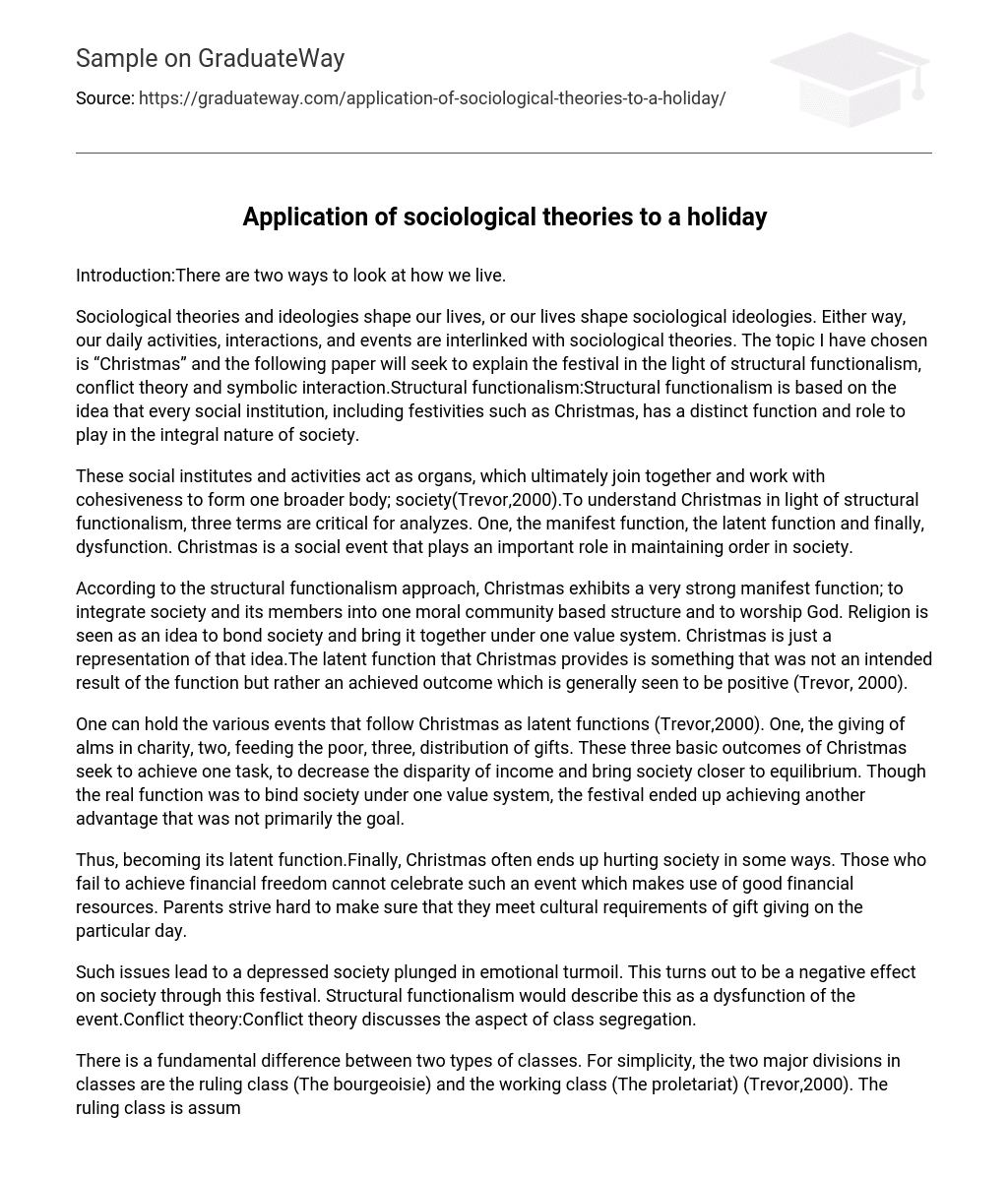Introduction:There are two ways to look at how we live.
Sociological theories and ideologies shape our lives, or our lives shape sociological ideologies. Either way, our daily activities, interactions, and events are interlinked with sociological theories. The topic I have chosen is “Christmas” and the following paper will seek to explain the festival in the light of structural functionalism, conflict theory and symbolic interaction.Structural functionalism:Structural functionalism is based on the idea that every social institution, including festivities such as Christmas, has a distinct function and role to play in the integral nature of society.
These social institutes and activities act as organs, which ultimately join together and work with cohesiveness to form one broader body; society(Trevor,2000).To understand Christmas in light of structural functionalism, three terms are critical for analyzes. One, the manifest function, the latent function and finally, dysfunction. Christmas is a social event that plays an important role in maintaining order in society.
According to the structural functionalism approach, Christmas exhibits a very strong manifest function; to integrate society and its members into one moral community based structure and to worship God. Religion is seen as an idea to bond society and bring it together under one value system. Christmas is just a representation of that idea.The latent function that Christmas provides is something that was not an intended result of the function but rather an achieved outcome which is generally seen to be positive (Trevor, 2000).
One can hold the various events that follow Christmas as latent functions (Trevor,2000). One, the giving of alms in charity, two, feeding the poor, three, distribution of gifts. These three basic outcomes of Christmas seek to achieve one task, to decrease the disparity of income and bring society closer to equilibrium. Though the real function was to bind society under one value system, the festival ended up achieving another advantage that was not primarily the goal.
Thus, becoming its latent function.Finally, Christmas often ends up hurting society in some ways. Those who fail to achieve financial freedom cannot celebrate such an event which makes use of good financial resources. Parents strive hard to make sure that they meet cultural requirements of gift giving on the particular day.
Such issues lead to a depressed society plunged in emotional turmoil. This turns out to be a negative effect on society through this festival. Structural functionalism would describe this as a dysfunction of the event.Conflict theory:Conflict theory discusses the aspect of class segregation.
There is a fundamental difference between two types of classes. For simplicity, the two major divisions in classes are the ruling class (The bourgeoisie) and the working class (The proletariat) (Trevor,2000). The ruling class is assumed to hold all factors of production, whereas the working class must sell their labor to make ends meet. According to the conflict theory, conflict between these two classes is inevitable.
The interaction between the two classes lead to eventual conflict as the labor class becomes aware of its underprivileged conditions (Trevor,2000).To apply the theory to the festival of Christmas, we must keep in mind the two classes, the bourgeoisie and the proletariat. According to Marx, the suppression of the proletariat is the key to the survival of the bourgeoisie. Therefore, many social institutes were set up by the ruling class to keep social order and obedience amongst the working class.
Religion was one such institution that was created to control the working class. According to Marx, religion is a poor man’s opium. By giving hope of a better life after death, the ruling class exploits the working class(Trevor,2000). The working class, in the never ending hope accepts their positions of subservience.
Christmas is a religious festival.In terms of conflict theory, Christmas is a festival that induces religion into the hearts of men and women. By promoting this event, the ruling class subdues any chances of rebellion and revolt from the working.Second, the festival also segregates the rich from the poor distinctly.
The festival has been transformed into a gift giving practice whereas the spirituality has been wiped out considerably. Only the rich can afford the lavish festival and celebrate in audacity by giving extravagant gifts to loved ones. The poor however are left to feed on hope alone. This festival, according to the conflict theory is bound to exercise revolution eventually (Trevor,2000).
The class conflict is evident in this structure as a clear line of difference exists between the rich and the poor in the celebration of Christmas.Symbolic interaction:Symbolic interaction is a subset of the interactionism school of thought. The ideology is based on a micro level train of thought focusing on the individual rather than the society as do the two preceding theories. Because of this nature, the highlight is on how an individual acts rather than reacts to social stimulus (Trevor,2000).
Interactionists believe that individuals and their interactions with each other are the causes of social change, progress and ultimately society. All symbolic interaction, including languages, gestures and institutions are seen as portrayal of thought by individuals.According to symbolic interactionism, social order exists, because an individual thinks it to exist and therefore continuously exhibits acts to convince others that it exists (Trevor,2000). Similarly, Christmas is seen as a festival existent only to convince others that God exists.
The symbols, the festivities and the gift giving behavior have only been incorporated by the human mind to convince others.Another perspective is on the workings of the Christmas festival. Each individual strives for social order (Trevor,2000). To maintain a routine and regularity, the festival is mimicked again and again by society, through each individual.
In the end, the festival is just a product of human imagination and thought process. It only symbolizes what individuals feel, want and expect from society.References:Noble , T.(2000).
Social Theory and Social Change. Palgrave Macmillan





